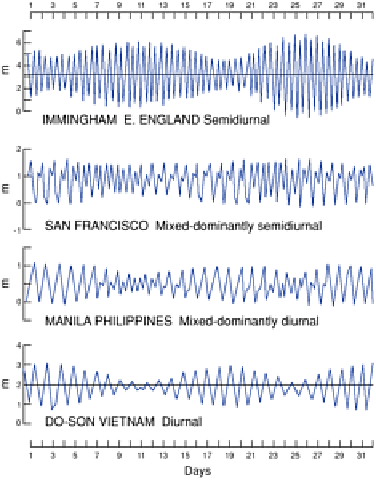Environmental Engineering Reference
In-Depth Information
proximity. The
semi-diurnal
tidal model, of two tides each day, is most applicable in
equatorial and mid-latitude waters. Polewards, one tide progressively dominates, giving
mixed
tides or, in high latitudes, a single
diurnal
tide (Figure 11.11). The sun adds 47 per
cent to tidal pull when both are in line, to form
spring tides
twice during each monthly
cycle, but reduces it by variable rates when they are not, reaching a lowest or
neap tide
when they pull at right-angles (Figure 11.10).
To understand why tidal levels and cycles are so complex, consider what might
happen on a featureless Earth covered by a single ocean five to ten times deeper than at
present. The moon would draw a tidal wave 0·5 m high at the equator, travelling at 1600
km hr
−1
in its wake - the magnitude of the moon's pull being slight but its rotation around
Earth fast. This does
not
happen because the global ocean is comparatively shallow, with
greater sea bed friction, and the moon's orbit 'wobbles' between 28·5° N and 28·5° S of
an equatorial plane. Moreover, it is interrupted by large continents and indented
coastlines. Thus tides which pass unobserved in mid-ocean are stacked up
disharmonically into confined coastal spaces
Figure 11.11
Representative tidal styles and ranges.
Source: After King (1962).
with varying shelf and shoreline slopes. This is illustrated by the
Severn bore
in the
Bristol Channel, which has one of Earth's largest tidal ranges of 12·2 m at Avonmouth.
The Severn estuary is 220 km long, 150 km wide at its mouth between Pembroke and
Cornwall but only 1·5 km wide near the Severn bridges. Tides lag by three hours between
its landward and seaward limit and are still rising inland when they begin to fall at sea. Its
funnel shape creates a progressive rise of water, sending a tidal wave or
bore
up-estuary,

